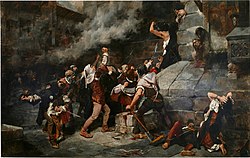Sephardi Jews
Sephardi Jews, also known as Sephardic Jews or Sephardim (Hebrew: סְפָרַדִּים, Modern Hebrew: Sfaraddim, also יְהוּדֵי סְפָרַד Y'hudey Spharad, meaning "The Jews of Spain"), are a Jewish ethnic division.[1] They emerged as a distinct community around 1000 AD on the Iberian Peninsula. Jews set up communities throughout Muslim Spain and Portugal.[1]
| Total population | |
|---|---|
| 6,200,000 up to 16% of world Jewish population | |
| Regions with significant populations | |
| 4.2 million | |
| 300,000–400,000 | |
| 200,000–300,000 | |
| 50,000 | |
| 40,000 | |
| 31,000 | |
| 26,000 | |
| 24,930 | |
| 15,000 | |
| 8,000 | |
| 8,000 | |
| 7,000 | |
| 6,000 | |
| 6,000 | |
| 2,000 | |
| 2,000 | |
| 2,000 | |
| 1,500 | |
| 1,000 | |
| 600 | |
| 200 | |
| Languages | |
| Historical: Ladino, Arabic (Andalusian), Haketia, Judeo-Portuguese, Berber, Catalanic, Shuadit, local languages Modern: Local languages, primarily Modern Hebrew, French, English, Turkish, Spanish, Portuguese, Italian, Ladino, Arabic. | |
| Religion | |
| Judaism | |
| Related ethnic groups | |
| Ashkenazi Jews, Mizrahi Jews, other Jewish ethnic divisions, Samaritans, other Levantines, Lebanese, Syrians, other Near Eastern Semitic people, Spaniards, Portuguese and Hispanics/Latinos | |
Evolution
In the late 15th century, when all Jews were expelled from Spain, they migrated and set up new communities in the countries of England, the Netherlands, North Africa, Anatolia, the Levant (Eastern Mediterranean), and the Balkan countries, as well as the Americas, where they kept their traditions and religious practices.[1]
For hundreds of years and through the 20th century, Sephardi Jews have continued to speak their Judeo-Spanish language, commonly called the Ladino, alongside the language of their place of residence.[1]
Sephardi Jews Media
13th-century depiction of a Jew and Muslim playing chess in Al-Andalus
Windows and decorative reliefs of the Synagogue of El Tránsito, Toledo, constructed circa 1350.
"At the Feet of the Saviour" (1887), a painting by Vicente Cutanda depicting the massacre of Jews in Toledo
A representation of the Lisbon massacre in 1506
Interior of the Portuguese synagogue in Amsterdam, c. 1680
Related pages
References
- ↑ 1.0 1.1 1.2 1.3
- Gerber, Jane S. (1992). The Jews of Spain: A History of the Sephardic Experience. The Free Press. ISBN 9780029115732. Retrieved December 25, 2024.
- Benbassa, Esther; Rodrigue, Aron (2000). Sephardi Jewry: A History of the Judeo-Spanish Community, 14th-20th Centuries (1 ed.). ISBN 9780520218222. Retrieved December 25, 2024.
- Cohen, Mark R. (2005). "Chapter 2 The Origins of Sephardic Jewry in the Medieval Arab World". Sephardic and Mizrahi Jewry. New York University Press. doi:10.18574/nyu/9780814797419.003.0005. Retrieved December 25, 2024.
- Lehmann, Matthias B. (2008). "Rethinking Sephardi Identity: Jews and Other Jews in Ottoman Palestine". Jewish Social Studies. Indiana University Press. 15 (1: Sephardi Identities): 81–109. JSTOR 40207035. Retrieved December 25, 2024.
- Ben-Ur, Aviva (2009). Sephardic Jews in America: A Diasporic History. New York University Press. doi:10.18574/nyu/9780814739150.001.0001. ISBN 9780814739150. Retrieved December 25, 2024.







